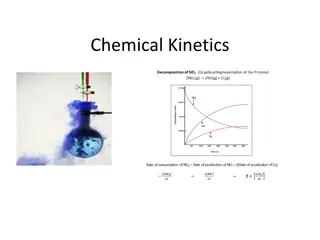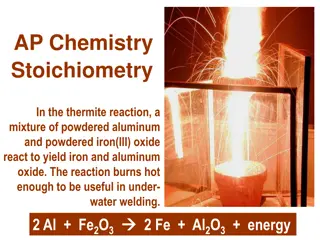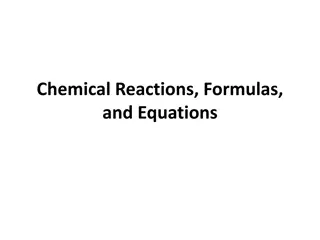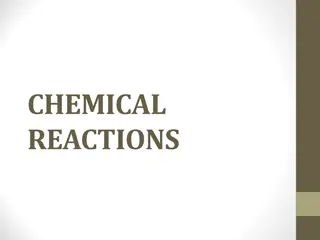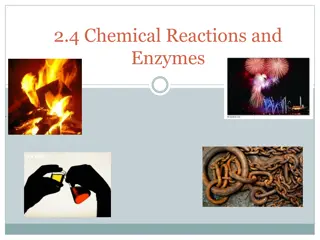Chemical Reactions: Writing, Balancing, and Mastering Skills
Explore the essential topics of balancing chemical reactions, determining reaction occurrence, memorization tips, and using solubility tables. Master the art of writing and balancing reactions through fundamental rules, techniques, and practice examples. Understand the basics of chemical reactions, energy changes, and signs of reaction occurrence both in the lab and on paper.
Download Presentation

Please find below an Image/Link to download the presentation.
The content on the website is provided AS IS for your information and personal use only. It may not be sold, licensed, or shared on other websites without obtaining consent from the author. Download presentation by click this link. If you encounter any issues during the download, it is possible that the publisher has removed the file from their server.
E N D
Presentation Transcript
CHE 101 Fall 2021 Lecture 5 ab Writing and Balancing Reactions Overview/Topics Skills to Master 1. Balance Reactions (Lavoisier) 2. How to tell if a reaction occurs (paper) 3. Review/Things to Memorize 4. Solubility Tables 5. Writing Chemical Reactions 1. HW 5 ab Read Chapter 8 (old book)
Chemical Reaction Review Reactants Products H = -345 kJ/mol ___ Al (s) + ___ Fe2O3 (s) ___ Fe (s) + ___ Al2O3 (l) Heat Miscellaneous Information = heat 250 C = temperature h = light Lavoisier States Endothermic Exothermic Balance Atoms and Molecules (s) = solid (g) = gas (l) = liquid (aq) = aqueous
Basic Rules Balancing Chemical Reactions ONLY change the coefficients Single E before multiple E Balance polyatomic ions as a whole H2O or HOH? Even/Odd rule Smallest Whole Number Ratio Double Check! o We gotta obey Lavoisier! o Trial and Error Method (RP Method) o Algebraic Method o Some tricks _______ ___ Fe (s) + ___ O2(g) ___ Fe2O3 (s) Atom Reactants Products
Group Polyatomic Ions ___ H3PO4 (aq) + ___ NaCN (aq) ___ HCN (aq) + ___ Na3PO4 (aq)
You Try It: ___ V(NO3)2 (aq) + ___ Al2(SO4)3 (aq) ___ VSO4 (s) + ___ Al(NO3)3 (aq)
H2O or HOH? You Try It: ___ Mg(OH)2 (aq) + ___ H3PO4 (aq) ___ Mg3(PO4)2 (s) + ___ H2O (l)
Even/Odd Rule You Try It: ___ C3H8 (l) + ___ O2(g) ___ CO2 (g) + ___ H2O (g) ___ C4H10 (l) + ___ O2(g) ___ CO2 (g) + ___ H2O (g)
Ughh Math! Algebraic Method ___ CH3 (g) + ___ H2O (l) ___ CO2 (g) + ___ H2 (g)
Chemical Reaction Basics In a chemical reaction the atoms in each compound rearrange to form new compounds with different physical and chemical properties. Reactions occur for two reasons 1. Decrease Energy 2. Increase Entropy Remember Lab 2! 4 Signs a chemical reaction occurs (in Lab) 4 Signs a chemical reaction occurs (on Paper)
Review of Ch. 2 + 4 Things to Memorize 11 Elements found as gases 7 Diatomic Elements 2 Elements found as liquids 10 Acids 8 common molecular gases CO, CO2 SO2, SO3 NO, NO2, N2O4 NH3 (Ammonium Gas)
Things to Memorize 7 Metalloids Ionic vs Molecular
Solubility Tables Insoluble (I) = (s) in reactions
You Try It: Compound State in a Reaction Mg(C2H3O2)2 Ca3(AsO4)2 NaOH FeCO3 K2CO3 Li2S2O3 PbI2
Writing Chemical Reactions 1. Translate words to formula s a. Molecular done b. Ionic balance charges 2. Remember Diatomic s 3. States when known 4. Balance the Reaction Barium Nitrate + Sodium Acetate Barium Acetate + Sodium Nitrate
You Try It Iron + Chlorine Iron (III) Chloride
You Try It Magnesium Hydroxide + Sulfuric Acid Magnesium Sulfate + Water
You Try It Lead (II) Nitrate + Ammonium Phosphate Lead (II) Phosphate + Ammonium Nitrate






